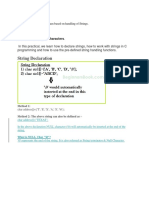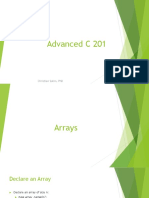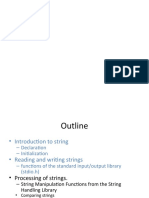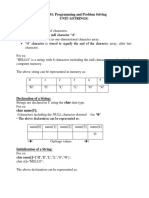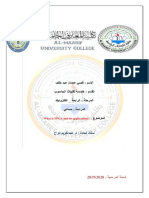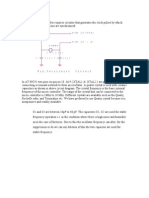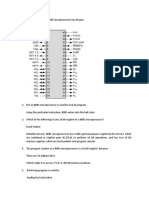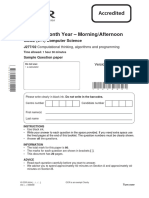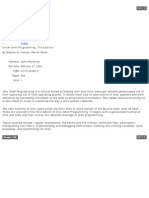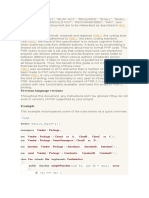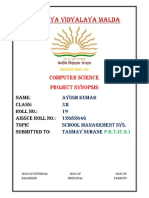CS 332/532 – 1G- Systems Programming
Lab 3
Objectives
The objective of this lab is to introduce you to dynamic memory allocation and strings in C
programming.
1. Go over the solution for Lab 02.
2. Illustrate how to use dynamic memory allocation and strings in C.
Exercises
Task 1
In this task first we will go over the solution of Lab 02 and compare the C and Java code.
• Download the C program (insertionsort.c), and the Java program
(InsertionSort.java).
• Now understand the C program and compare it with the given Java code.
Task 2
Create a function to perform the insertion sort. Now the program will perform the following
steps:
1. Prompt the user to enter the number of array elements (say, N).
2. Read the number of elements (N).
3. Use dynamic memory allocation to allocate an array of N single precision floating-point elements
(C type float).
4. Read the N single precision floating-points elements to the allocated array.
5. Invoke a function to sort the array using insertion sort (the insertion sort function should take the
array reference and number of elements as the arguments and sort the array in-place). The
insertion sort function should have the return type as void, i.e., it does not return anything.
�6. Print the sorted array.
Code snippets
1. Function Declaration
void displayArray(float *arr, int size);
void sortArray(float *arr, int size);
2. Function definition
void displayArray(float *arr, int size){
printf("[");
for (int i=0; i<size-1; i++) {
printf("%f, ",arr[i]);
}
printf("%f]\n", arr[size-1]);
}
3. Function call/invocation
displayArray(arr, N);
sortArray(arr, N);
4. Dynamic memory allocation for array
float *arr = (float*) malloc(N * sizeof(float));
Task 3
In C, there is no primitive datatype called string. Strings are implemented as an array of
characters typically terminated with the null character (\0). For example:
char hello[6] = {‘H’, ‘e’, ‘l’, ‘l’, ‘o’, ‘\0’};
// OR
char hello[] = "Hello\0";
Note: When you initialize an array of characters, it is a good idea to add the null character -
`\0' as the terminating character.
�Now let’s see few helpful functions for character array manipulation. For this action you need
to include the header file called “string.h”.
• strlen: To get the length of string.
• strcpy: To copy one string to another.
• strcat: To concatenate one string to another.
• strcmp: To compare one string to another string. This will return integer value based on the two
string compared. The return value is 0 if the two strings are equal, greater than 0 if first string is
greater than the second string, and less than 0 if the first string is less than the second string and
the comparison is performed using unsigned characters.
• strchr: To search first occurrence of a character in the given string. This will return either a pointer
to the first occurrence or NULL if not found.
• strstr: To search first occurrence of a sub-string in a given string. This will return either a pointer to
the first occurrence of the sub-string or NULL if not found.
Now, let’s use some of these functions. Also, you can find out more about these functions by
typing man <functionname>. For example:
man strcpy
Implement following examples for string manipulations:
Example 1:
#include <stdio.h>
#include <string.h>
int main(int argc, char** argv) {
char hello[20] = {'h','e','l','l','o',' ','\0'};
char name[] = "students!\0";
strcat(hello, name);
printf("%s\n",hello);
return 0;
}
Note: the strcat function concatenate second string (name) into first string (hello), also notice
that hello has one extra space before string termination to print “hello students!” with space
between “hello” and “students!”.
Example 2:
�#include <stdio.h>
#include <string.h>
int main(int argc, char** argv) {
char student1[] = "Alice\0";
char student2[] = "Bob\0";
char student3[] = "bob\0";
char student4[] = "Alice\0";
printf("strcmp(student1, student2) = %d\n", strcmp(student1, student2));
printf("strcmp(student2, student1) = %d\n", strcmp(student2, student1));
printf("strcmp(student2, student3) = %d\n", strcmp(student2, student3));
printf("strcmp(student1, student4) = %d\n", strcmp(student1, student4));
return 0;
}
Note: The strcmp function performs a character by character lexicographic comparison to
compare the two strings.
Lab Assignment #3
Modify the insertion sort program developed in Lab #2 such that the program now sorts
strings (array of characters) instead of floats and uses dynamic memory allocation to allocate
memory based on the number of elements in the array as well as the length of individual
strings. You can use scanf function to read the strings, determine the length of the string, and
then allocate appropriate amount of memory. Also use separate functions to read the strings,
sort the strings, and display the sorted strings. Use appropriate string functions provided by
the C library. A list of functions and details about each function can be found
at: https://en.cppreference.com/w/c/string/byte (Links to an external site.).
Submission
Upload the C source file (.c file) to Canvas as part of this lab submission. Make sure to test the
program on GitHub codespaces and include instructions to compile and run the program in the
comments section of your program. Please do not upload executables. And don’t forget your
README.md file
































